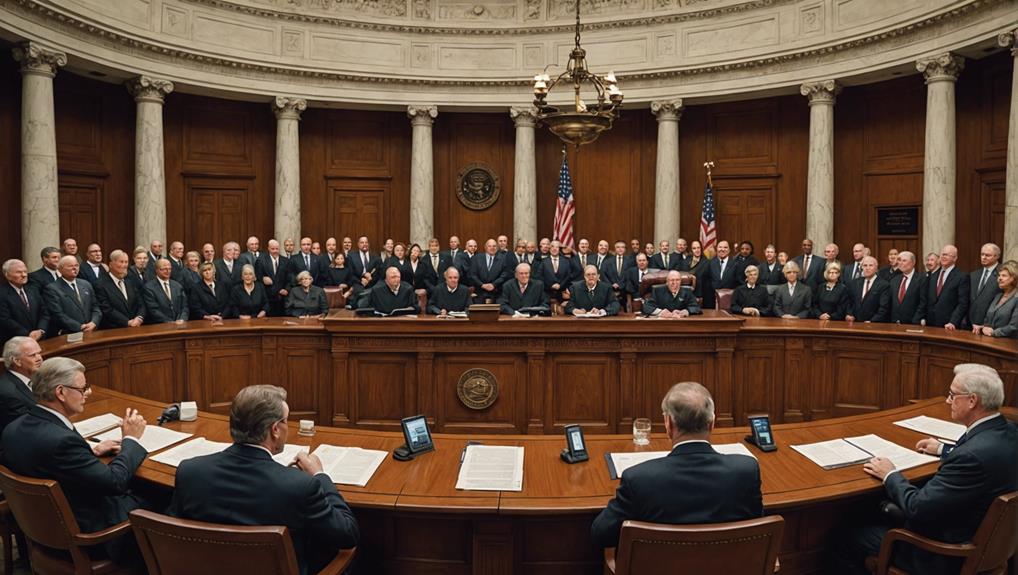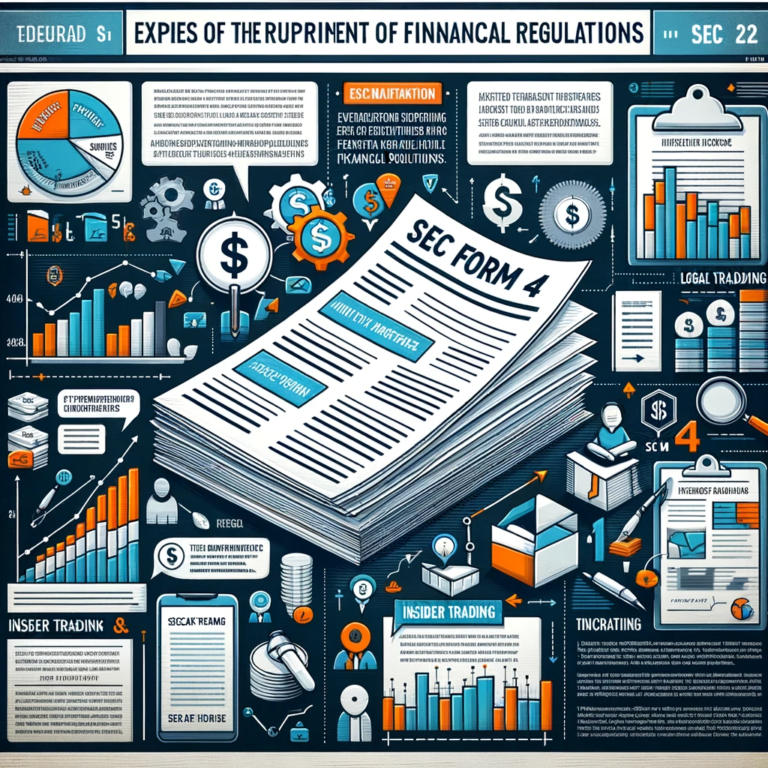When Was The SEC Formed?

When Was The SEC Formed: The U.S. Securities and Exchange Commission (SEC) was established on June 6, 1934, as part of President Franklin D. Roosevelt‘s New Deal program. This significant regulatory body was a direct response to the 1929 stock market crash, with the aim of preventing future financial crises. The SEC’s primary mission is to oversee and regulate financial markets, protect investors, and ensure market integrity. It operates under the authority of the Securities Act of 1933 and the Securities Exchange Act of 1934, enforcing laws to combat fraud, promote transparency, and uphold fair trading practices. The SEC plays a crucial role in shaping the financial landscape and instilling investor confidence over the decades.
The SEC, as a federal agency, holds regulatory authority over various aspects of the securities industry, including oversight powers, enforcement actions, and market surveillance. It regulates the registration and activities of investment advisers, broker-dealers, and self-regulatory organizations, ensuring compliance with market integrity rules and securities laws. By monitoring market participants, trading platforms, and securities offerings, the SEC aims to provide investors with essential information, maintain fair and efficient markets, and prevent market manipulation and insider trading. Through its enforcement division, the SEC takes actions to protect investors, promote market integrity, and uphold the regulatory framework of the securities industry.
The SEC’s role in overseeing corporate disclosure, regulatory filings, and market practices contributes to the overall integrity and efficiency of the financial system. By enforcing disclosure requirements, exchange regulations, and market integrity standards, the SEC safeguards investor interests, promotes financial stability, and enhances stakeholder confidence in the securities market. Its regulatory initiatives, enforcement actions, and compliance programs are essential for maintaining fair and efficient markets, ensuring accountability, and upholding the highest standards of market conduct.
The SEC’s regulatory oversight and enforcement authority play a critical role in protecting investors, preserving market integrity, and promoting economic development through transparent and well-regulated capital markets.
Key Takeaways
The Securities and Exchange Commission (SEC) was established on June 6, 1934, as a regulatory body by the U.S. government. Its formation was a response to the 1929 stock market crash, under President Franklin D. Roosevelt’s New Deal program. The SEC’s history is rooted in the need to oversee financial markets and protect investors in the aftermath of the devastating crash.
The SEC derives its authority from key pieces of legislation, namely the Securities Act of 1933 and the Securities Exchange Act of 1934. These laws empower the SEC to enforce regulations that promote transparency, investor confidence, and market integrity. By ensuring corporate disclosure from public companies and regulating securities offerings, the SEC plays a crucial role in safeguarding investor interests and maintaining the integrity of the financial system.
As a federal agency, the SEC is entrusted with the responsibility of enforcing securities laws, combating market manipulation and insider trading, and setting regulatory standards for market participants. Its oversight powers extend to registration, compliance, and enforcement actions to uphold market surveillance and protect against financial fraud. Through its enforcement division, the SEC works to maintain fair and efficient markets while promoting capital formation and market conduct that benefits all stakeholders.
What is the SEC?

The Securities and Exchange Commission (SEC) is a crucial U.S. federal agency responsible for safeguarding investors, ensuring market fairness, and promoting capital formation. Established on June 6, 1934, under President Franklin D. Roosevelt’s New Deal program, the SEC was a direct response to the 1929 stock market crash, aiming to prevent such catastrophic events from reoccurring.
The SEC’s primary mission revolves around maintaining the integrity and transparency of financial markets. By enforcing securities laws such as the Securities Act of 1933 and the Securities Exchange Act of 1934, the SEC acts as a regulatory authority overseeing corporate disclosure and regulating public companies. This regulatory body’s role extends to market oversight, enforcement actions, and investor protection, all vital components for sustaining investor confidence and market integrity.
The establishment of the SEC marked a pivotal moment in U.S. financial history, shaping the regulatory framework for the securities industry. Through its enforcement division, the SEC exercises oversight powers to ensure compliance with market regulations, combat market manipulation and insider trading, and enhance transparency for all market participants.
Why was the SEC formed?
The SEC was established in response to the 1929 stock market crash, which caused widespread panic among investors. This event highlighted the urgent need for stricter oversight and regulation of the financial markets. In 1934, the U.S. government created the Securities and Exchange Commission (SEC) to restore investor confidence and ensure the integrity of the market.
The SEC’s formation marked a turning point in the history of stock market regulation. By enacting the Securities Act of 1933 and the Securities Exchange Act of 1934, the SEC gained the authority to oversee both primary and secondary securities markets. This regulatory body was tasked with enforcing securities laws, preventing market manipulation, and promoting transparency in corporate disclosures.
Through its regulatory powers, the SEC aimed to protect investors and maintain a level playing field for all market participants. By setting standards for financial transparency and cracking down on fraudulent activities like insider trading, the SEC played a critical role in safeguarding the interests of individual investors and ensuring the stability of the financial system.
What is the Purpose of the SEC?

Let’s peak into the establishment of the Securities and Exchange Commission (SEC). Formed in 1934, the SEC is a crucial regulatory body within the U.S. government that plays a pivotal role in overseeing the financial markets. Its primary mission is to protect investors, ensure fair and efficient markets, and facilitate capital formation.
Through the enforcement of securities laws such as the Securities Act of 1933 and the Securities Exchange Act of 1934, the SEC upholds market integrity and transparency, thereby bolstering confidence in the U.S. financial system.
The SEC’s history is intertwined with the evolution of stock market regulation in the United States. Since its inception, the SEC has been instrumental in enforcing regulations, conducting oversight, and enhancing investor protection. By regulating corporate disclosure and ensuring that public companies adhere to regulatory requirements, the SEC acts as a vital regulatory authority in the securities industry.
Its oversight powers extend to compliance, market manipulation, insider trading, and ensuring transparency among market participants.
The SEC serves as a guardian of investor interests, market integrity, and the overall stability of the financial system. Through its enforcement actions, market surveillance efforts, and registration of investment advisers and broker-dealers, the SEC plays a crucial role in maintaining fair and efficient markets.
What is the Mission of the SEC?
The Securities and Exchange Commission, commonly known as the SEC, was established in 1934 by the U.S. government as a regulatory body overseeing the financial markets. Its formation followed the enactment of key legislation, including the Securities Act of 1933 and the Securities Exchange Act of 1934. These laws aimed to bring transparency to stock market regulation and enforce regulatory oversight.
The SEC’s history is rooted in its mission to protect investors, maintain market integrity, and ensure fair and efficient markets. Through its enforcement powers, the SEC enforces federal securities laws that govern the conduct of market participants, such as brokers, dealers, and investment advisers. By upholding these laws, the SEC promotes investor confidence and upholds market integrity.
In addition to enforcement actions, the SEC focuses on investor education, providing resources to help individuals make informed financial decisions. By promoting transparency and disclosure, the SEC empowers investors to safeguard themselves against financial fraud and misconduct. This commitment to investor education is essential for ensuring a level playing field in the financial markets.
The SEC plays a crucial role in facilitating capital formation by providing regulatory frameworks for companies, especially small businesses, to access the capital they need to grow and innovate. By overseeing securities offerings and registration requirements, the SEC supports economic development and job creation. Through its regulatory initiatives, the SEC promotes market efficiency and investor confidence, contributing to the overall stability of the financial system.
What are the Functions of the SEC?
Let’s look into the primary functions of the Securities and Exchange Commission (SEC), the regulatory body established by the U.S. government to oversee and enforce securities laws. Formed in response to the Stock Market Crash of 1929, the SEC plays a crucial role in protecting investors, ensuring market integrity, and promoting capital formation in the financial markets.
The SEC’s main functions include enforcing regulations to prevent fraudulent activities, maintaining fair and efficient markets through oversight and rule-making, and facilitating capital formation by ensuring transparent financial disclosures. These functions are essential for building trust and stability in the U.S. securities industry.
The SEC’s regulatory authority extends to a wide range of areas, including market surveillance, registration of investment advisers and broker-dealers, enforcement actions against market manipulation and insider trading, and setting transparency standards for market participants. By upholding regulatory compliance and enforcing securities laws, the SEC plays a vital role in safeguarding investor interests and maintaining the integrity of the financial system.
1. Protecting Investors
The Securities and Exchange Commission (SEC) was established in 1934 as a regulatory body by the U.S. government to oversee the securities industry and enforce securities laws. Formed in response to the stock market crash of 1929 and the subsequent Great Depression, the SEC plays a crucial role in ensuring market integrity and protecting investor interests.
The SEC’s history is deeply intertwined with the development of securities regulation in the United States. The Securities Act of 1933 and the Securities Exchange Act of 1934 were landmark pieces of legislation that granted the SEC regulatory authority over various aspects of the securities industry. These laws aimed to promote transparency, prevent fraud, and safeguard investor confidence in the financial markets.
As a federal agency, the SEC is responsible for enforcing securities laws, regulating securities offerings, and overseeing the conduct of market participants. Through its enforcement division, the SEC takes enforcement actions against violations of securities laws, such as market manipulation and insider trading, to uphold market integrity and protect investors from financial fraud.
The SEC’s oversight powers extend to a wide range of market participants, including public companies, investment advisers, broker-dealers, and self-regulatory organizations. By setting and enforcing market integrity rules, the SEC helps maintain fair and efficient markets where investors can trade with confidence.
The SEC plays a key role in promoting investor education and ensuring that market participants comply with regulatory filings and disclosure requirements.
2. Maintaining Fair and Efficient Markets
The Securities and Exchange Commission (SEC) was established in 1934 as a regulatory body by the U.S. government to oversee the financial markets and protect investor interests. The SEC’s formation was a response to the Great Depression, aiming to restore investor confidence and ensure market integrity. Since its establishment, the SEC has played a crucial role in enforcing securities laws, such as the Securities Act of 1933 and the Securities Exchange Act of 1934, to regulate stock market activities and promote transparency.
As a federal agency, the SEC has been entrusted with the responsibility of enforcing securities regulations and overseeing various market participants, including public companies, investment advisers, broker-dealers, and self-regulatory organizations. Its oversight powers extend to monitoring corporate disclosures, combating financial fraud, and ensuring compliance with market integrity rules. By upholding regulatory standards and enforcing laws, the SEC contributes to the stability and efficiency of the financial system.
The SEC’s enforcement division is dedicated to investigating and taking enforcement actions against violations of securities laws, such as market manipulation and insider trading. Through its market surveillance efforts and regulatory initiatives, the SEC aims to protect investors, maintain market integrity, and promote fair and efficient markets.
3. Facilitating Capital Formation
The establishment of the Securities and Exchange Commission (SEC) in 1934 marked a significant milestone in the history of regulatory bodies in the United States. Formed in response to the stock market crash of 1929 and the subsequent Great Depression, the SEC was tasked with overseeing the financial markets and protecting investor interests. Its creation was a pivotal moment in the evolution of securities regulation and marked a shift towards greater transparency and accountability in the securities industry.
Since its inception, the SEC has played a crucial role in safeguarding the integrity of the financial system. Through its enforcement of federal securities laws, such as the Securities Act of 1933 and the Securities Exchange Act of 1934, the SEC has worked to prevent market manipulation, insider trading, and other forms of misconduct. By promoting transparency and fair practices among market participants, the SEC has helped to foster investor confidence and ensure the smooth functioning of capital markets.
One of the core functions of the SEC is to oversee corporate disclosure by public companies. By requiring companies to disclose information about their securities and operations, the SEC helps to ensure that investors have access to the information they need to make informed decisions. This commitment to transparency not only protects investors but also promotes market integrity and efficiency.
In addition to its regulatory oversight of companies and market participants, the SEC also plays a key role in enforcing compliance with securities laws. Through enforcement actions, the SEC holds individuals and entities accountable for violations of securities regulations, sending a clear message that misconduct won’t be tolerated. This enforcement function is essential for maintaining the integrity of the financial system and upholding the SEC’s mission to protect investors and facilitate capital formation.
What are the Laws that Govern the SEC?

The Securities and Exchange Commission (SEC) was established in 1934 as a regulatory body by the U.S. government to oversee financial markets and protect investors. It plays a crucial role in enforcing securities laws and ensuring market integrity. The SEC’s history is intertwined with the development of stock market regulation and the need for effective enforcement and oversight in the securities industry.
The SEC derives its regulatory authority from key pieces of legislation such as the Securities Act of 1933 and the Securities Exchange Act of 1934. These laws grant the SEC the power to regulate securities offerings, provide investor information, and oversee trading platforms. The SEC’s primary focus is on ensuring transparency, preventing market manipulation, and protecting investors from fraudulent activities.
As a federal agency, the SEC is responsible for enforcing securities laws, promoting investor education, and taking enforcement actions against violations. Its enforcement division plays a vital role in investigating misconduct, ensuring compliance with regulations, and maintaining market surveillance. By upholding the integrity of the financial system, the SEC contributes to economic stability and investor confidence.
The SEC’s regulatory framework encompasses a wide range of areas, including registration requirements for investment advisers and broker-dealers, market surveillance, disclosure standards, and enforcement authority. Through its regulatory initiatives and oversight functions, the SEC aims to safeguard investor interests, promote market integrity, and uphold the integrity of the financial services industry.
The SEC’s role in ensuring fair and efficient markets is crucial for maintaining stakeholder confidence and fostering economic development.
1. Securities Act of 1933
Formed in 1934, the Securities and Exchange Commission (SEC) is a vital regulatory body established by the U.S. government to oversee and enforce securities laws. Its history is intertwined with the development of the financial markets and the protection of investor interests. The SEC plays a crucial role in maintaining market integrity and ensuring that public companies adhere to disclosure requirements.
The SEC’s primary mandate is to regulate the securities industry, which includes enforcing the Securities Act of 1933 and the Securities Exchange Act of 1934. Through its oversight powers, the SEC monitors stock market regulation, enforcement actions, and corporate disclosure to safeguard investor confidence and market integrity. By focusing on transparency and compliance, the SEC aims to protect market participants from fraudulent activities and promote fair and efficient markets.
As a federal agency, the SEC has the authority to enforce securities regulations, investigate market manipulation and insider trading, and oversee the registration and compliance of investment advisers, broker-dealers, and self-regulatory organizations. Its role in overseeing market surveillance and ensuring investor protection is instrumental in maintaining the integrity of the financial system and upholding the public trust in the capital markets.
The SEC’s enforcement division plays a crucial role in upholding market conduct and enforcing regulations to protect investor interests. By monitoring market participants, enforcing compliance programs, and regulating corporate governance, the SEC contributes to the stability and transparency of the financial markets. Its focus on information disclosure, exchange regulation, and market practices helps maintain the integrity of securities exchanges and financial intermediaries.
In essence, the SEC’s regulatory framework is designed to promote market efficiency, safeguard investor interests, and enhance stakeholder confidence in the financial services industry. Through its enforcement authority, regulatory initiatives, and market surveillance efforts, the SEC plays a pivotal role in upholding market integrity standards and ensuring the protection of investors in the ever-evolving securities market landscape.
2. Securities Exchange Act of 1934
Expanding on the groundwork laid by the Securities Act of 1933, the Securities Exchange Act of 1934 led to the formation of the Securities and Exchange Commission (SEC) to oversee the regulation of secondary markets and ensure the integrity of the market. Recognizing the crucial role of investor confidence in a robust financial system, this act mandated that companies provide accurate and comprehensive information about their securities. This transparency empowers investors like us to make informed decisions about where to invest our money.
The establishment of the SEC marked a significant milestone in the history of securities regulation in the United States. Tasked with the responsibility of preventing insider trading and ensuring fair treatment by brokers, dealers, and exchanges, the SEC plays a vital role in maintaining a level playing field for all market participants. Through its enforcement actions, the SEC upholds market integrity and provides a sense of security for investors.
Following the tumultuous period of the Great Depression, the creation of the SEC symbolized a beacon of hope, aiming to restore public trust in the U.S. financial markets. The agency’s powers were further strengthened in the aftermath of the 2007-2008 financial crisis, underscoring its critical role in financial oversight and investor protection.
3. Investment Company Act of 1940
The formation of the Securities and Exchange Commission (SEC) in 1934 marked a pivotal moment in U.S. financial history. Established as a regulatory body by the U.S. government, the SEC plays a crucial role in overseeing the financial markets and protecting investor interests. With the implementation of the Securities Act of 1933 and the Securities Exchange Act of 1934, the SEC gained authority over stock market regulation, enforcement, and oversight.
The SEC’s primary mission is to maintain investor confidence and market integrity through the enforcement of securities laws and regulations. By requiring corporate disclosure from public companies, the SEC enhances transparency and accountability in the financial system. This regulatory authority extends to overseeing securities transactions, enforcing compliance, and combating market manipulation and insider trading.
Investor protection is at the core of the SEC’s mandate, as it strives to ensure the fairness and efficiency of capital markets. Through its enforcement division, the SEC monitors market conduct, enforces regulations, and safeguards shareholder rights. By imposing registration requirements on investment advisers, broker-dealers, and trading platforms, the SEC aims to provide investors with essential information and uphold market integrity standards.
The SEC’s regulatory framework is designed to promote market transparency, integrity, and stability. By setting disclosure standards, enforcing compliance, and updating regulatory policies, the SEC contributes to the economic development and investor confidence.
Through its oversight functions and enforcement actions, the SEC plays a vital role in maintaining fair and efficient markets while protecting investor interests and fostering stakeholder confidence in the financial services industry.
4. Investment Advisers Act of 1940
After the U.S. government established the Securities and Exchange Commission (SEC) and implemented its initial regulatory framework, the Investment Advisers Act of 1940 further fortified protections for investors. This Act set forth regulations for investment advisers, mandating their registration with the SEC. By requiring registration, the Act aimed to ensure that investment advisers adhere to strict compliance standards, enhancing transparency and integrity in their operations.
Under the Investment Advisers Act of 1940, advisers overseeing assets above a certain threshold must register with the SEC, subjecting themselves to rigorous regulatory oversight. This registration process enables the SEC to monitor and enforce adherence to regulations, fostering a reputable investment advisory sector. Through upholding fiduciary duties, investment advisers are bound by law to prioritize their clients’ best interests, offering impartial and well-informed guidance.
The Act introduced specific guidelines governing the behavior of investment advisers, emphasizing the maintenance of elevated ethical norms. These provisions are crucial for bolstering investor trust and shielding against fraudulent practices.
When was the SEC formed?
Let’s peak into the pivotal events that led to the birth of the Securities and Exchange Commission (SEC). The stock market crash of 1929 and the subsequent Great Depression profoundly shook public trust in the financial markets, highlighting the critical necessity for regulation. In response to this urgent need, President Franklin D. Roosevelt’s New Deal saw the establishment of the SEC on June 6, 1934. This move aimed to instill confidence and ensure transparency in securities transactions, marking a significant development in the history of market oversight and investor protection.
The formation of the SEC represented a decisive step by the U.S. government to address the regulatory gaps exposed by the financial turmoil of the 1930s. With a clear mandate to enforce securities laws, including the Securities Act of 1933 and the Securities Exchange Act of 1934, the SEC emerged as a key regulatory body entrusted with overseeing the conduct of market participants and safeguarding investor interests. Its role in ensuring market integrity, corporate disclosure, and regulatory compliance has been instrumental in fostering transparency and upholding the integrity of the financial system.
Since its inception, the SEC has played a crucial role in enhancing market efficiency, promoting investor confidence, and facilitating capital formation. Through its enforcement division and regulatory initiatives, the SEC has taken proactive measures to combat financial fraud, market manipulation, and insider trading, thereby bolstering the resilience of the securities market.
What were the events leading to the formation of the SEC?
Following the devastating 1929 stock market crash, there arose a pressing need for regulatory measures to curb widespread financial abuses and restore public trust in the financial system. The crash, alongside the ensuing Great Depression, severely eroded public confidence and underscored the glaring lack of transparency within the financial industry. This tumultuous period highlighted the critical necessity for a structured framework to oversee securities transactions and uphold market integrity.
In response to these turbulent events, the Securities Exchange Act of 1934 was introduced as a pivotal measure. Its primary objective was to regulate the securities markets and safeguard the interests of investors, signifying a significant shift towards transparency in the financial industry. The Act aimed to rebuild public confidence by enforcing laws that would deter fraudulent practices and market manipulations.
Recognizing the imperative of securing our financial futures, the formation of the SEC under President Franklin D. Roosevelt’s New Deal initiative marked a crucial advancement in this direction. With Joseph P. Kennedy Sr. assuming the role of its first chairman, the SEC embarked on a mission to instill accountability and transparency in the financial markets, laying the groundwork for the protection and empowerment of investors that endures to this day.
Who is in charge of the SEC?

The SEC, officially known as the Securities and Exchange Commission, was established in 1934 as a regulatory body within the U.S. government. Its formation marked a pivotal moment in the history of financial markets, as it was created to provide oversight and enforcement of securities laws, including the Securities Act of 1933 and the Securities Exchange Act of 1934. This marked a significant step towards ensuring investor protection, market integrity, and corporate disclosure in the United States.
The SEC’s role in stock market regulation, enforcement, and oversight is crucial for maintaining investor confidence and market integrity. As a federal agency empowered by legislation, the SEC holds regulatory authority over the securities industry, with a focus on overseeing compliance, preventing market manipulation, and combating insider trading. By promoting transparency and accountability among market participants, the SEC plays a key role in safeguarding the integrity of the U.S. financial system.
The SEC’s responsibilities extend to a wide range of areas, including investor education, enforcement actions, market surveillance, registration of investment advisers and broker-dealers, and oversight of self-regulatory organizations.
Through its regulatory efforts and enforcement actions, the SEC aims to protect investors, prevent financial fraud, and ensure market efficiency. By upholding independence and accountability in its regulatory functions, the SEC contributes to the stability and fairness of capital markets in the United States.
What are the Major Achievements of the SEC?
The Securities and Exchange Commission (SEC) was established in 1934 by the U.S. government to regulate the securities industry and protect investors. Its formation followed the passage of key securities laws, notably the Securities Act of 1933 and the Securities Exchange Act of 1934, which aimed to restore investor confidence in the stock market after the Great Depression. The SEC quickly became a vital regulatory body overseeing corporate disclosure, public companies, and stock market regulation.
Since its establishment, the SEC has played a crucial role in enhancing market integrity, investor protection, and financial stability. Through its regulatory authority, the SEC has proposed and adopted over 50 significant rule packages, addressing critical areas post-financial crisis. These reforms have improved market structure and oversight, ensuring transparency and resilience in our financial markets.
A major achievement of the SEC lies in its vigorous enforcement efforts. By setting records in enforcement actions and focusing on areas of concern such as market manipulation and insider trading, the SEC has demonstrated its commitment to protecting investors and upholding market integrity. The increase in the investment adviser examination staff by over 20% further strengthens its oversight capabilities.
Diversity initiatives have also been a cornerstone of the SEC’s recent efforts. By establishing a final interagency policy statement on diversity standards, the SEC encourages regulated entities to adopt stronger diversity policies, fostering an inclusive environment within the financial sector. These initiatives reflect the SEC’s dedication to promoting diversity and inclusion in the industry.
In addition to its enforcement and diversity efforts, the SEC has approved initiatives like the Tick Size Pilot NMS plan and improved public transparency of administrative proceedings, further enhancing market structure and investor protection. Collaborations such as the Conference on the Regulation of Financial Markets highlight the SEC’s commitment to dynamic and effective rulemaking, ensuring fair and resilient financial markets.
These achievements underscore the SEC’s unwavering dedication to maintaining a fair and transparent financial system for all stakeholders.
Conclusion
Established on June 6, 1934, the Securities and Exchange Commission (SEC) was formed as a regulatory body by the U.S. government to oversee the financial markets and protect investors from fraud. Its establishment marked a pivotal moment in the history of stock market regulation, as the SEC was granted enforcement and oversight powers to enhance investor confidence and market integrity.
The SEC’s primary focus has been on enforcing securities laws, such as the Securities Act of 1933 and the Securities Exchange Act of 1934, to ensure corporate disclosure by public companies and regulate securities transactions. This regulatory authority has been instrumental in maintaining transparency and accountability in the securities industry, safeguarding the interests of investors and promoting market stability.
Over the years, the SEC has played a crucial role in monitoring market participants, enforcing compliance with regulations, and combating market manipulation and insider trading. By upholding market integrity standards and overseeing the conduct of financial market participants, the SEC has contributed to the efficiency and fairness of capital markets, fostering investor confidence and industry professionalism.
As a federal agency with a mandate to protect investors, facilitate capital formation, and ensure fair and efficient markets, the SEC continues to evolve its regulatory framework to address new challenges and emerging trends in the financial services industry. Through its enforcement division, market surveillance efforts, and regulatory initiatives, the SEC remains committed to upholding the integrity of securities markets and promoting economic development through investor protection and market transparency.






